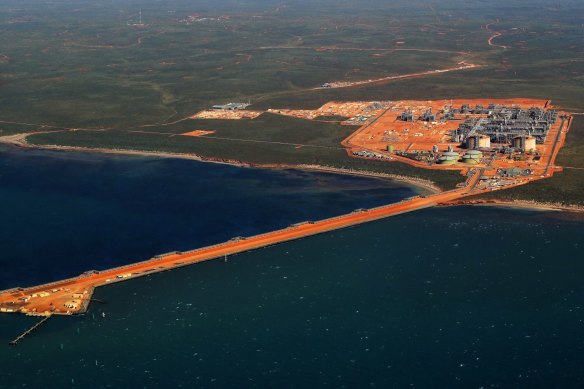- Analysis
- National
- WA
- Biodiversity
WA’s eco-watchdog rejected Gorgon. Chevron’s performance has proved it right
By Peter Milne
Two isolated areas off the northern West Australian coast have three things in common: they are biodiversity hotspots; near vast gas fields; and they are viewed very differently by WA governments and their independent environment watchdog.
WA Premier Roger Cook faces a tough choice on Woodside’s Browse project off the Kimberley coast, near Scott Reef, next year if the Environmental Protection Authority sticks with its preliminary view that Browse is environmentally unacceptable.

Beaches either side of the Gorgon jetty where turtles nest are being eroded.Credit: Bloomberg
He might want to consider how his predecessor Mark McGowan’s decision on Chevron’s Gorgon project on Barrow Island has played out.
In 2006, the EPA identified five areas where Chevron’s plans could not make the risk to the environment from Gorgon acceptably low, justifying its recommendation that the project did not proceed.
Its concerns were rare flatback turtles that nested in large numbers near where a jetty would be built; the introduction of non-indigenous species to Barrow Island where many native species thrived as they could no longer on the mainland; vast quantities of climate-warming carbon dioxide to be released to the atmosphere; subterranean fauna; and damage to the marine environment from dredging.
Despite this, then environment minister Mark McGowan gave Chevron and its partners ExxonMobil and Shell the green light.
“I’m confident that everything that can be done to manage the risks is being done,” the future premier said in 2009.
That wording is key: McGowan justified the go-ahead because he thought Chevron would do all it could, not because he was convinced those efforts would be effective.
McGowan may be right that Chevron tried its best, but just eight years into Gorgon’s planned operating life of more than half a century, those efforts have failed in at least three of the EPA’s five areas of concern.
In 2023, this masthead revealed the Department of Water and Environmental Regulation was investigating Chevron for beach erosion near the Gorgon jetty, where turtles nest, and failures of its quarantine system to keep out invasive species.
A Chevron spokesman said at the time it took its obligations seriously and was committed to environmental stewardship on Barrow Island.
A department spokesman said the investigations were continuing, and it was considering all regulatory options.
Chevron has also struck trouble with the world’s largest attempt to store greenhouse gases to reduce global heating.
When the EPA first assessed Gorgon, Chevron had not committed to burying underground the millions of tonnes a year of carbon dioxide it would pump out of the gas field as it could be “technically infeasible or cost prohibitive.”
The watchdog thought anything less than a high percentage of the reservoir CO₂ being stored was unacceptable.
The US giant committed to burying at least 80 per cent of that CO₂ before McGowan approved Gorgon in 2009.
After eight years of gas production and a cost of more than $3 billion, Chevron is injecting only about a third of the reservoir CO₂. Its concerns about technical feasibility and cost have been realised.
Going forward 15 years Cook seems to plan a similar approach to the Browse decision as McGowan had with Gorgon, telling this masthead his environment minister Reece Whitby would “consider the extent to which any environmental risks can be managed.”
Once again the test is not how well the environment is protected, but how hard the gas company is trying.
Such a criterion makes it likely that behind-the-scenes corporate lobbying will overwhelm independent scientific expertise produced in a detailed and open process.
Start the day with a summary of the day’s most important and interesting stories, analysis and insights. Sign up for our Morning Edition newsletter.